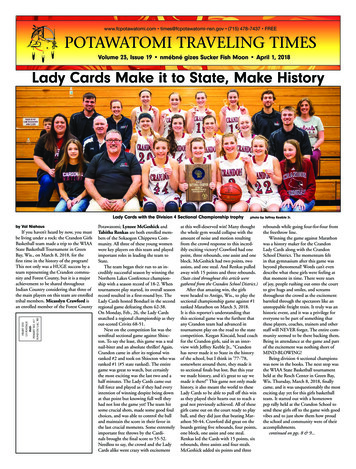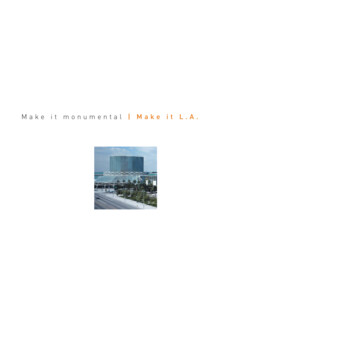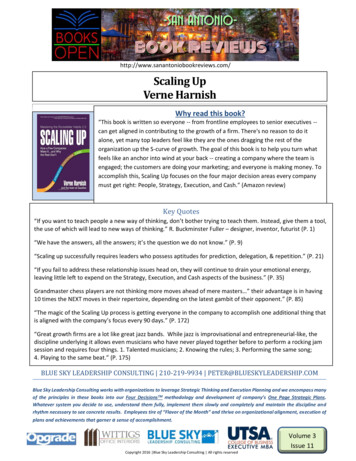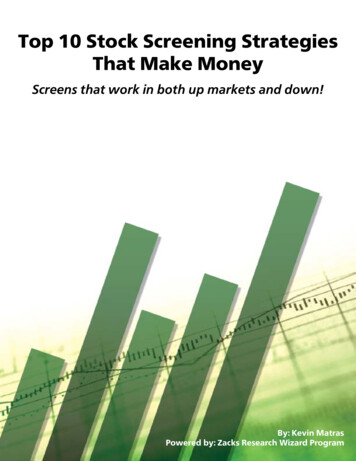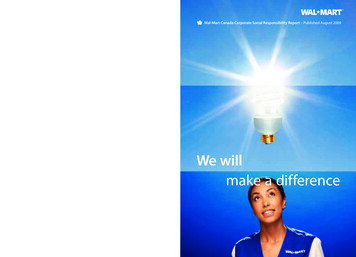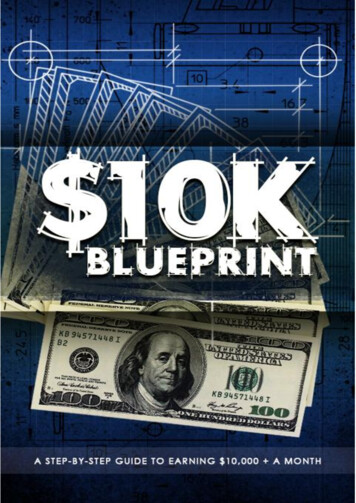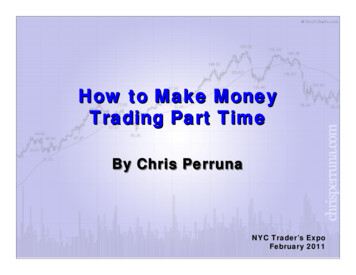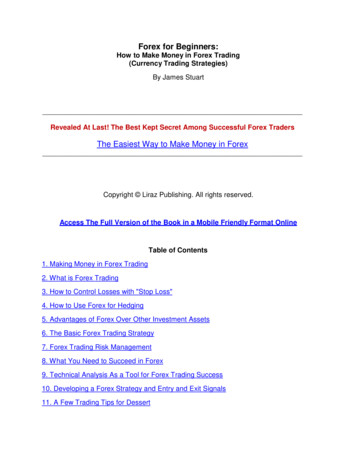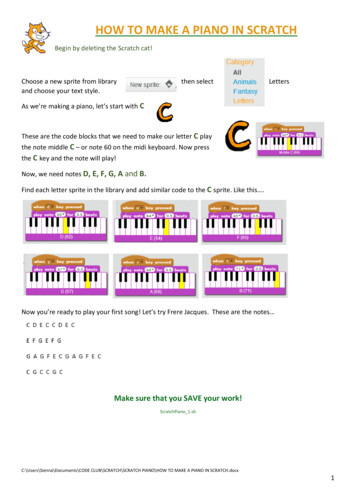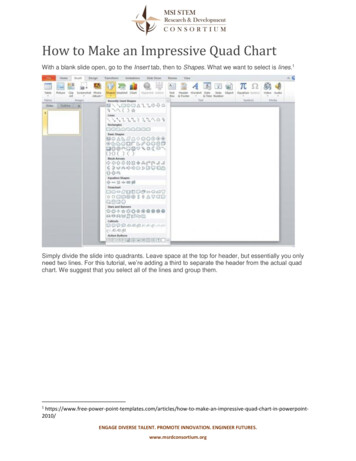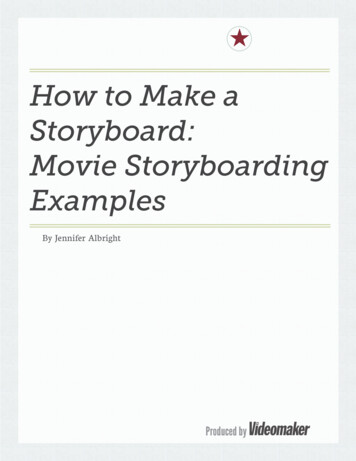
Transcription
How to Make aStoryboard:Movie StoryboardingExamplesBy Jennifer AlbrightProduced by1
How to Make a Storyboard:Movie Storyboarding ExamplesIntroduction to Storyboarding.3The Different Types of Shots. 4Depicting Camera Movement. 7The 180 Degree Rule.10Some Final Hints. 132
How to Make a Storyboard:Movie Storyboarding ExamplesIntroduction to StoryboardWhen you set out to make a movie, the more planning ahead you can do, the better. Figuring out exactly what you’ll be doing during a shoot saves your crew time andlabor, and saves you, the producer and/or director, from cost overruns and productionheadaches. A storyboard is one method of planning ahead. By visualizing your shotsahead of time with a storyboard, you can see how your shots fit together before you’veshot a single foot of film or kilobit of video, which will prevent you from wasting bothtime and footage. A good storyboard allows you to show your crew what you have inmind, and saves you from trying to convey what you want with wordy explanationsand frustrated hand gestures. When you show your DP and cameraperson your boards,they will immediately know what type of shot you need and how to frame the subjects.While you were learning about filmmaking, paying your dues as a PA or other crewmember, or even just searching around the internet, you may have seen elaboratelydetailed storyboards by professional artists. Boards like this are nice, but you don’tneed to be a talented artist to storyboard effectively. Even simple stick figures can givepeople a good idea of what your shot sequence will look like. For example, take a lookat the following illustration:The example above may be crude, but it’s clearly a two-shot with one character close to the camera.In other words, rudimentary art skills are perfectly fine. What you do needto know, however, is how you’re going to frame the subjects of your film. Abasic knowledge of camera shots, paired with a few simple perspective tricks,will enable you to map out your scene in an easy-to-read visual shorthand.3
How to Make a Storyboard:Movie Storyboarding ExamplesThe Different Types of ShotsLet’s begin with a quick rundown of basic shots and what they look like:LONG SHOT:Generally speaking, a long shot will include the entire body of the subject or subjects.MEDIUM SHOT:A medium shot will usually depict your subject anywhere from above the knees andup to just above the waist and up. Remember not to cut off your subjects right at theknees, or any other juncture of the body. It looks awkward and poorly composed. Try toframe them just above or below the joint in question.4
How to Make a Storyboard:Movie Storyboarding ExamplesCLOSE UP:Close ups are where we most often see the emotional content of a scene. They allow usto see the character’s faces up close, and thus their state of mind. Close ups are usuallyframed from the chest up. Occasionally, however, they can be framed from forehead tochin, or will even involve just the subject’s eyes. We call this an:EXTREME CLOSE UP:Extreme close ups add drama. For the most part, they’re used sparingly, but a singleECU can add a real punch to a scene.5
How to Make a Storyboard:Movie Storyboarding ExamplesMASTER SHOTA quick note about the master shot: this is a term referring to a shot that runs forthe length of a scene and shows all of the characters in view. It’s the most conservative way of staging a scene. Think of a master shot as being like watching a play fromsomewhere out in the audience. You see the entire set and where the characters are inrelation to each other on the stage. In older films, and multiple-camera productions likesitcoms, scenes often begin with a master shot in order to orient the audience, and allof the rest of the shots in the scene relate back to this shot. Most single-camera productions don’t rely so heavily on the master shot; however, keeping the master shot inmind can help you plan out the rest of your shot list. For example, in a scene depictinga conversation between two people, you may decide to cut to close ups of each persontalking, plus an insert shot of an item that they’re talking about, and then cut back tothe master shot after each one. This is a very basic way of editing a scene.There are also some special shots you might want to use in your storyboard. Here area couple of examples.POVPOV, or the point-of-view shot, is just that: it allows the audience to see what’s goingon through a character’s eyes. The easiest way to indicate this is to show a characterlooking at something, and then cut to what they’re looking at from an angle that makesit look as though the camera is in that character’s place. Here’s a storyboarded example.In this scene, a woman is working at her desk when the family dog enters the frame.The woman looks down and sees the dog looking up at her, wagging his tail.Notice how the juxtaposition of shots conveys the woman’s POV to the audience.POV shots tend to be used sparingly, although there have been some films with entiresequences shot from a character’s point of view. In fact, the 1947 film noir Lady in theLake was shot entirely from the POV of the main character.6
How to Make a Storyboard:Movie Storyboarding ExamplesDepicting Camera MovementNow that we’ve talked about some basic shots, let’s go over some important cameramovements, and ways to depict them on the page.PANPanning involves a sideways or up/down rotation of the camera on the tripod. It’s oneway to put the camera on another subject without cutting to a different shot. It canalso be used to follow a character or characters when they’re moving within the frame.A panning shot can be depicted by first placing a couple of frames in order to showwhere the camera will start and where it will end up, and then adding arrows to describe the camera movement. In the illustration below, we see a panning shot for asimple dialogue scene.As depicted, the camera moves first from one set of characters, and then to the other.The arrows show the direction of movement.7
How to Make a Storyboard:Movie Storyboarding ExamplesTRACKA tracking shot is another way to follow a subject or subjects. This type of shot involves moving the entire camera from one place to another, instead of merely rotatingthe camera body on a fixed point. Tracking can involve moving the camera with tracksor on a dolly, or it can be done hand-held.In this shot, the camera follows the mother as she runs. Note the arrow showing thecamera direction.ZOOMZooming is a movement of the camera lens as opposed to a movement of the cameraitself. Zooming in means adjusting the lens to frame in closer on the subject, whilezooming out means the opposite: adjusting the lens to take in more of the scene.Here’s an illustrated depiction of a zoom:The interior frame indicates where the shot begins. As the action proceeds, the camera pulls out, as shown by the arrows. The outside frame shows where the shot finishes:on a wide angle showing the entire room and all the characters in frame.8
How to Make a Storyboard:Movie Storyboarding ExamplesWhat if you don’t need the camera itself to move, but want to show characters moving into, out of, or through the frame during a shot? An easy way to do this is by drawing arrows.Arrows can also depict smaller movements within the frame, such as a head turning.9
How to Make a Storyboard:Movie Storyboarding ExamplesThe 180 Degree RuleNow that we’ve covered the basics, here are a couple of other things to keep in mindwhen setting up your shots. Firstly, you may have heard people talk about “not crossingthe line” when they’re setting up a scene. They’re using a slang term for the 180 degreerule, which is a very important rule of thumb for filmmaking. We’ll demonstrate thisrule with a simple dialogue scene. Here’s the master shot, showing Bill and Carol seatedat a table together:Now imagine this scene from overhead, with a straight line running through the middle of the subjects, like so:Keeping your camera on the same side of this line—aka the 180 degree line-- will assure visual continuity and prevent your viewers from becoming disoriented.10
How to Make a Storyboard:Movie Storyboarding ExamplesHere is the same diagram with a few possible camera placements. Notice that shots A,B and C are on the same side of the line.Let’s put shots A, B, and C into a storyboard. It will end up looking like this:ABCThis shot sequence adheres to the 180 degree rule. Bill and Carol are having a conversation. First we have a master shot of the two of them, showing the audience wherethey are in the scene and where they are in relationship to each other (shot A). Next isa close up of Bill (shot B), and then one of Carol (shot C). When the individual shotsare edited together, Bill and Carol appear to be facing each other, just as they are in themaster shot.11
How to Make a Storyboard:Movie Storyboarding ExamplesNow let’s try putting together shots A, B, and D from the diagram. The storyboardwill look like this:ABDThis shot sequence is disorienting because it breaks the 180 degree rule. Notice howBill and Carol now look like they’re facing the same direction, rather than looking ateach other across the table? Keeping your camera on one side of the action will saveyou a big headache in the editing room!12
How to Make a Storyboard:Movie Storyboarding ExamplesSome Final HintsNow that you’re equipped with some visual references and a basic shot vocabulary,here are a couple of other things to remember. As we’ve just seen, a good storyboardcan prevent you from directing scenes that are disorienting or visually monotonous.When you’ve illustrated your shots beforehand, you get a “sneak peek” at how they’llcut together. On the flip side of the coin, don’t go overboard with dozens of differentshots. Remember that each shot involves time to set up, which burns crew time andlabor.Finally, it always pays off to practice! You can do this even if you don’t have a scriptof your own to work on. Get a DVD of one of your favorite movies and choose a memorable scene from it. Sit down with a pencil and some paper and go through the sceneshot by shot. Copy each shot onto your paper, using the examples in this article as areference (remember, stick figures are OK!). As you draw, think about the shot choice.How does the selection of shots contribute to the overall feel of the scene? Are therelots of emotive close ups, or does the director use wide shots to convey distance or loneliness? Does he or she stick closely to the master shot, or is the scene full of movement?Looking at the work of other directors can teach you a lot about how scenes are puttogether. You don’t even have to pick up a camera to do it!About the Author: Jennifer Albright is a UCLA film school alumnus and Los Angelesbased illustrator whose storyboard clients include Fox Sports Marketing. Her illustration work can be seen at www.trickunicorn.com.13
How to Make a Storyboard:Movie Storyboarding ExamplesVisit Videomaker.com to learn more aboutcreating and publishing great video!Looking for more information on making great video?Check out these helpful resources.Training Resources: http://www.videomaker.com/training/Videomaker Workshops: er Webinars: r Facebook: 77Videomaker Twitter: http://twitter.com/#!/videomakerVideomaker YouTube: http://www.youtube.com/user/videomaker14
Movie Storyboarding Examples MASTER SHOT A quick note about the master shot: this is a term referring to a shot that runs for the length of a scene and shows all of the characters in view. It’s the most conserva-tive way of staging a scene. Think of a master shot as being like watching a play from somewhere out in the audience. You see the entire set and where the characters are inFile Size: 2MBPage Count: 14
